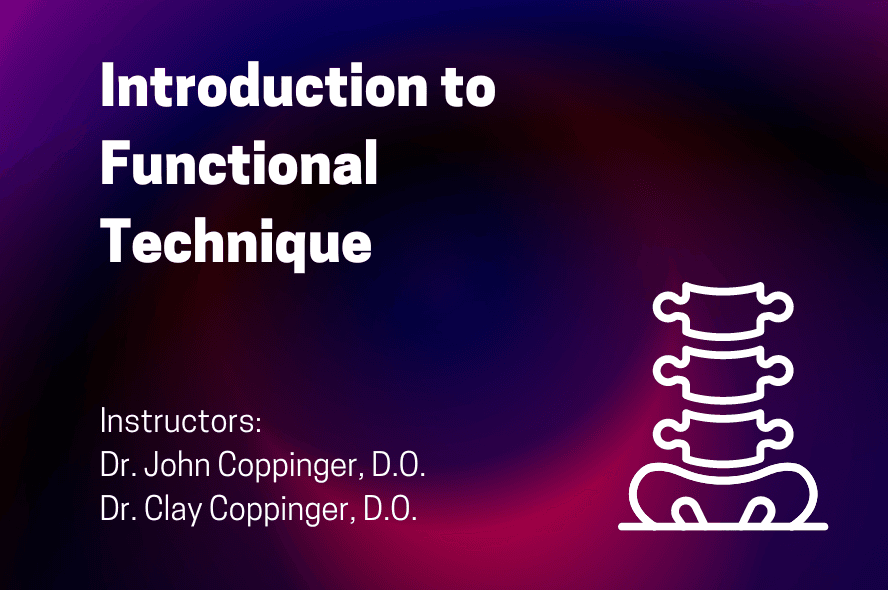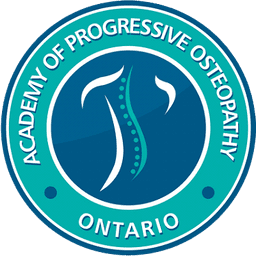Introduction to Functional Techniques
Back to courses
Outcome Measures:
- Participants will have a greater understanding of the history and theory of Functional techniques and the concepts of ‘ease’, and ‘ease vs bind’.
- Participants will have a greater understanding of the pertinence as well as a basic competency in the following techniques:
Strain/Counterstrain
Indirect Myofascial Technique
Facilitated Positional Release Technique
Balanced Ligamentous Tension - Attendees will have an understanding and basic ability to apply the concept of the term precision diagnostics.
- Attendees will have a greater understanding and a basic competence to conduct a case history.
- Participants will have a greater understanding of the therapeutic application of Functional Technique as well as an enhanced ability to shift from one technique to another as dictated by the needs of the patient.
Day 1 Morning
- Housekeeping
An introduction to the Course Instructor and Course Assistant.
A brief session on getting to know the course participants. - Osteopathic concepts
- Osteopathic lesion.
A discussion on the use of the term ‘osteopathic lesion’ including the history of the term and its use today within an osteopathic manual practice. - Indirect technique.
One of the major differences between manual osteopathic technique and other manual therapy modalities is the use of indirect technique. There will be a definition of what is meant by the term indirect technique, as well as a brief discussion of the history of the term and its use in osteopathic manual technique, and the differences between the concept of direct technique and indirect technique. - The terms ease and bind are important to the study of indirect technique, there will be a discussion of those terms and their use in Functional Technique.
- The use of the term ease is prevalent in cranial osteopathy, there will be a discussion of the connection between functional technique and cranial osteopathic technique and the use of the term ease.
- Osteopathic lesion.
- What are functional techniques? Discussion on the use of the term functional technique within an osteopathic manual practice, and some of the more often discussed techniques within the genre will be introduced.
- Motion present/permitted will be defined. Synchronizing with motion present or motion permitted is a key step in the process
- Strain/Counterstrain, although not really considered functional technique, will be discussed as a functional technique because it provides a greater understanding of the genre.
- iMFR, or indirect Myofascial Release, will be discussed as one of the genres of Functional Techniques.
- FPR, Facilitated Positional Release, will be discussed as a member of the genre of Functional Technique.
- Lastly the classic technique BLT or Balanced Ligamentous Tension will be defined and discussed, including how this technique relates to the cranial concept.
Day 1 Afternoon
- General diagnostic approaches
- Standing and seated with the Stiles algorithm
- Supine screening
- Video of screening/diagnostics
Day 2 Morning
- Introduction to SCS, Strain/Counterstrain;
- History. The history of the technique as an osteopathic technique, that evolved accidently from frustration and need.
- Theoretical pathway of effect. A discussion on how Strain/Counterstrain can influence the patient’s system in a therapeutic context. The clinical indications for the use of Strain/Counterstrain within a therapeutic context.
- Diagnosis. How does one diagnose the need for the use of the Strain/Counterstrain technique, the clinical symptoms and signs that would indicate the need for the application of a Strain/Counterstrain Technique.
- Treatment. What does the treatment process look like? What should the practitioner expect? What should the patient expect?
- Re-evaluation. A key aspect to any therapeutic intervention, what differences should one expect in the patient presentation after the use of a Strain/Counterstrain technique.
- Lecture and Lab including demonstration of the process of
evaluation, the application and re-evaluation of
Strain/Counterstrain technique.
- Introduction to iMFR, indirect Myofascial Release.
- The history of Myofascial Release and the differences between direct Myofascial Release versus indirect Myofascial Release.
- Theoretical pathway of effect and mechanism of action. A discussion on how indirect Myofascial Release can influence the patient’s system in a therapeutic context. The clinical indications for the use of indirect Myofascial Release within a therapeutic context.
- Diagnosis. How is does one diagnose the need for the use of the indirect Myofascial Release technique, the clinical symptoms and signs that would indicate the need for the application of an indirect Myofascial Release Technique.
- Treatment. What does the treatment process look like? What should the practitioner expect? What should the patient expect?
- Re-evaluation. A key aspect to any therapeutic intervention, what differences should one expect in the patient presentation after the use of an indirect Myofascial Release technique.
- Lecture and Lab including demonstration of the process of evaluation, the application and re-evaluation of indirect Myofascial Release technique.
Day 2 Afternoon
- Introduction to FPR, Facilitated Positional Release.
- The history of Facilitated Positional Release and what makes it different from other osteopathic functional techniques, such as iMFR.
- Theoretical pathway of effect and mechanism of action. A discussion on how Facilitated Positional Release can influence the patient’s system in a therapeutic context. The clinical indications for the use of Facilitated Positional Release within a therapeutic context.
- Diagnosis. How does one diagnose the need for the use of the Facilitated Positional Release technique, the clinical symptoms and signs that would indicate the need for the application of a Facilitated Positional Release Technique.
- Treatment. What does the treatment process look like? What should the practitioner expect? What should the patient expect?
- Re-evaluation. A key aspect to any therapeutic intervention, what differences should one expect in the patient presentation after the use of a Facilitated Positional Release technique.
- Lecture and Lab including demonstration of the process of evaluation, the application and re-evaluation of Facilitated Positional Release technique.
- Introduction to BLT, Balanced Ligamentous Tension.
- History. The history of the technique as an osteopathic technique, that evolved from earlier osteopathic techniques and practice, and its role in the evolution of osteopathic cranial technique.
- Theoretical pathway of effect. A discussion on how Balanced Ligamentous Tension can influence the patient’s system in a therapeutic context. The clinical indications for the use of Balanced Ligamentous Tension within a therapeutic context.
- Diagnosis. How does one diagnose the need for the use of the Balanced Ligamentous Tension technique, the clinical symptoms and signs that would indicate the need for the application of a Balanced Ligamentous Tension Technique.
- Treatment. What does the treatment process look like? What should the practitioner expect? What should the patient expect?
- Re-evaluation. A key aspect to any therapeutic intervention, what differences should one expect in the patient presentation after the use of a Balanced Ligamentous Tension technique.
- Lecture and Lab including demonstration of the process of evaluation, the application and re-evaluation of Balanced Ligamentous Tension technique.
Day 3 Morning
- Lecture on the term ‘Precision Diagnostics’.
The term Precision Diagnostics refers to the decision-making process in which the practitioner has to consider which tissues are involved with the diagnosis and which technique that will ensure maximal therapeutic benefit for the patient. - Lecture on the art of taking a Case History Taking.
There will be a discussion on the importance of taking a proper case history, as part of the treatment process and on the methodology of how to conduct a case history. - Review of material.
There will be a review on the material presented during the previous two days including practical demonstration and labs based on the concepts and techniques of Days One and Two.
Day 3 Afternoon
- Advanced therapeutic concepts related to functional technique.
There will be a discussion on how to shift between one technique versus another within the same treatment session. In a therapeutic intervention, the needs of the patient can sometimes shift unpredictably.
“Be where you are when you’re there”
In a therapeutic context, the practitioner has to be able to shift and adapt to the evolving needs of the patient. The lecture for this afternoon will focus on topics such as how to recognize the need to transition and how to manage a transition within a session. This lecture and following lab will focus on developing the skill of ‘shifting between techniques’ and staying attune to the needs of the patient’s system at any given moment within the therapeutic process.
Day 4 Morning
- A review of the material covered in days One through Three and a recap of integrated treatment in the Functional Model.
- Q and A.
During the question and answer session there will be the opportunity for participants to ask questions, discuss clinical scenarios and have a conversation about the experience of the first three days of the course.
Day 4 Afternoon
- Introduction to concepts of Biodynamics as they evolved from the theory and practice of Indirect Technique. There will be a brief examination of the concepts of self-healing and how the therapist can synchronize with these powerful therapeutic forces within the treatment session, with the self-healing and self-correcting systems in the body. There will be a discussion on the value of the use of therapeutic communication and cooperation.
- Conclusion and parting remarks.
Dates:
- 2024-06-13
- 2024-06-14
- 2024-06-15
- 2024-06-16
Cost: $1300 CAD
